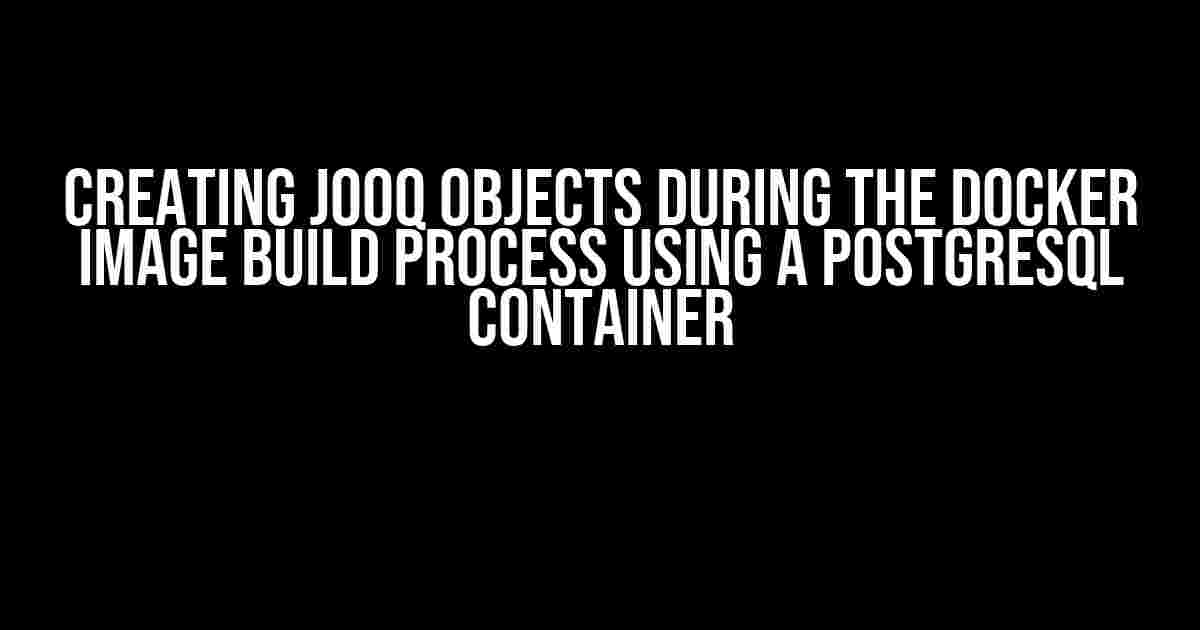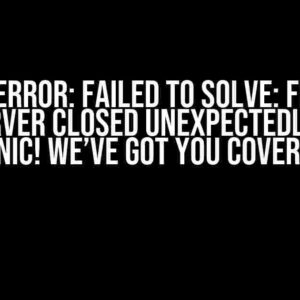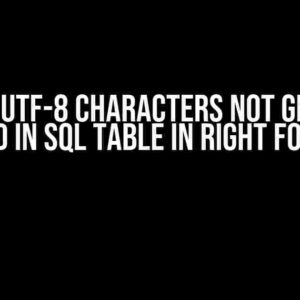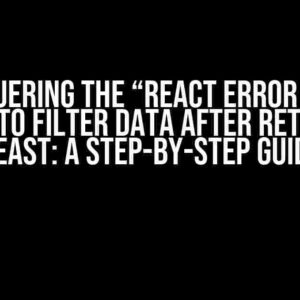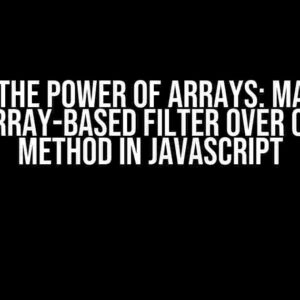As a developer, you know how important it is to have a seamless and efficient development process. When working with databases, creating JOOQ objects can be a crucial step in ensuring your application interacts with the database correctly. But what if you want to create these objects during the Docker image build process, using a PostgreSQL container?
The Benefits of Creating JOOQ Objects During the Docker Image Build Process
Creating JOOQ objects during the Docker image build process offers several benefits. Firstly, it ensures that your database schema is correctly reflected in your JOOQ objects, reducing the risk of errors and inconsistencies. Secondly, it allows you to version control your database schema alongside your application code, making it easier to track changes and collaborate with team members.
Additionally, creating JOOQ objects during the build process enables you to leverage the benefits of Docker’s layered architecture. By creating the objects during the build process, you can ensure that they are only generated once, reducing the overall size of your Docker image and improving deployment efficiency.
Prerequisites
Before we dive into the process, make sure you have the following prerequisites in place:
- Docker installed on your machine
- A PostgreSQL container running on your Docker network
- JOOQ installed and configured in your project
- A PostgreSQL database schema created and available
Step 1: Create a Dockerfile for Your Application
Start by creating a Dockerfile for your application. This file will contain the instructions for building your Docker image.
FROM java:8
# Set the working directory to /app
WORKDIR /app
# Copy the JAR file and dependencies
COPY target/your-app.jar /app/
COPY target/dependency/*.jar /app/
# Expose the port for your application
EXPOSE 8080
# Set the environment variables
ENV POSTGRES_URL=jdbc:postgresql://db:5432/your-db
ENV POSTGRES_USER=your-user
ENV POSTGRES_PASSWORD=your-password
# Create the JOOQ objects during the build process
RUN java -cp /app/your-app.jar:/app/dependency/jooq-3.14.4.jar org.jooq.codegen.GenerationTool /app/jooq-config.xml
In the above example, we’re using a Java 8 base image, setting the working directory to `/app`, and copying the JAR file and dependencies into the container. We’re also exposing port 8080 for our application and setting environment variables for our PostgreSQL connection.
Step 2: Configure JOOQ GenerationTool
Next, you need to configure the JOOQ GenerationTool to generate the JOOQ objects during the build process. Create a `jooq-config.xml` file in the root of your project with the following content:
<?xml version="1.0" encoding="UTF-8"?>
<configuration>
<jdbc>
<url>${POSTGRES_URL}</url>
<user>${POSTGRES_USER}</user>
<password>${POSTGRES_PASSWORD}</password>
</jdbc>
<generator>
<name>org.jooq.codegen.DefaultGenerator</name>
<database>
<name>org.jooq.meta.postgres.PostgresDatabase</name>
<schemata>
<schema>
<inputSchema>public</inputSchema>
</schema>
</schemata>
</database>
<generate>
<pojos>true</pojos>
<Records>true</Records>
<Interfaces>true</Interfaces>
</generate>
<target>
<packageName>com.yourcompany.yourapp.generated</packageName>
<directory>/app/generated</directory>
</target>
</generator>
</configuration>
In this configuration file, we’re specifying the database connection details, the generator settings, and the target package and directory for the generated JOOQ objects.
Step 3: Run the Docker Build Process
Now that you have your Dockerfile and JOOQ configuration in place, it’s time to run the Docker build process. Open a terminal and navigate to the root of your project. Run the following command:
docker build -t your-app .
This will start the Docker build process, which will create the JOOQ objects during the build process using the PostgreSQL container.
Step 4: Verify the Generated JOOQ Objects
Once the build process is complete, you can verify that the JOOQ objects have been generated correctly. Run the following command to start a new container from the built image:
docker run -p 8080:8080 your-app
This will start a new container from the `your-app` image and map port 8080 from the container to your local machine. You can then use a tool like `psql` to connect to the PostgreSQL database and verify that the JOOQ objects have been generated correctly.
Troubleshooting Common Issues
During the build process, you may encounter some common issues. Here are some troubleshooting tips to help you resolve them:
| Error Message | Solution |
|---|---|
| (“Connection to the database failed: FATAL: password authentication failed for user \”your-user\””) | Verify that the environment variables for the PostgreSQL connection are set correctly in the Dockerfile. |
| (” Unable to find the database schema”) | Verify that the PostgreSQL database schema exists and is correctly configured in the JOOQ configuration file. |
| (“Error generating JOOQ objects: java.lang.OutOfMemoryError: Java heap space”) | Increase the Java heap size by adding the following flag to the `RUN` command in the Dockerfile: `-Xmx1024m` |
Conclusion
In this article, we’ve shown you how to create JOOQ objects during the Docker image build process using a PostgreSQL container. By following these steps and configuring JOOQ correctly, you can ensure that your database schema is correctly reflected in your JOOQ objects, reducing the risk of errors and inconsistencies.
Remember to version control your database schema alongside your application code, and leverage the benefits of Docker’s layered architecture to reduce the overall size of your Docker image and improve deployment efficiency.
With these instructions, you’re now well-equipped to create JOOQ objects during the Docker image build process, and take your application development to the next level.
Frequently Asked Question
Get answers to the most pressing questions about creating JOOQ objects during the Docker image build process using a PostgreSQL container!
Why do I need to create JOOQ objects during the Docker image build process?
Creating JOOQ objects during the Docker image build process allows you to generate database schema-specific code at build time, ensuring that your application is always in sync with your database schema. This approach also enables you to benefit from compile-time checks and auto-completion features, making your development process more efficient.
How do I create a PostgreSQL container during the Docker image build process?
You can create a PostgreSQL container during the Docker image build process by adding a Docker Compose file to your project. This file defines the services required for your application, including the PostgreSQL container. In your Dockerfile, you can then use the `docker-compose up` command to start the PostgreSQL container, create the database schema, and generate the JOOQ objects.
What are the benefits of using a PostgreSQL container during the Docker image build process?
Using a PostgreSQL container during the Docker image build process provides a consistent and reproducible environment for generating JOOQ objects. This approach ensures that your application is database-agnostic, making it easier to switch between different database vendors or versions. Additionally, it allows you to test your application with a realistic database setup, reducing the likelihood of integration issues.
How do I configure JOOQ to generate objects during the Docker image build process?
To configure JOOQ to generate objects during the Docker image build process, you need to create a `jooq-config.xml` file that defines the database connection settings and the desired generation configuration. In your Dockerfile, you can then use the `jooq-codegen` command to generate the JOOQ objects based on the configured settings.
How do I avoid database connection issues during the Docker image build process?
To avoid database connection issues during the Docker image build process, make sure to use a retry mechanism when attempting to connect to the PostgreSQL container. You can use tools like `wait-for-it` or `dockerize` to wait for the database container to be ready before generating the JOOQ objects. Additionally, ensure that your Docker Compose file and `jooq-config.xml` file are correctly configured to use the correct database credentials and connection settings.

